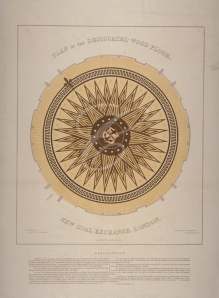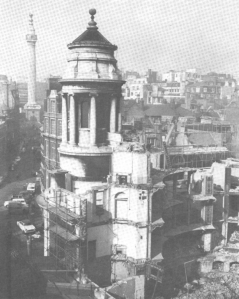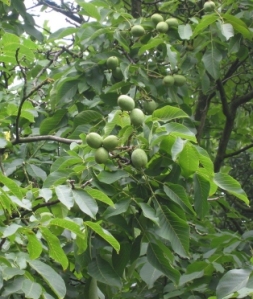A little while ago, Oxford University plant scientist Barrie Juniper, author of The Tradescants’ Orchard, and co-author with his daughter Sarah of a forthcoming new commentary on Evelyn’s Acetaria, contacted me on the subject of the Sayes Court Park mulberry tree. It was this tree that drew me in to investigate the history of Sayes Court to begin with, and I’ve written about it twice already on this blog, (here and here) so you might reasonably wonder what more there could be to say about it.
Well, it turns out it’s rather a mysterious specimen from the genetic point of view. According to the usual accounts, the mulberry was introduced to Britain under King James 1 in the early seventeenth century, in a failed attempt to establish a home-grown silk industry here. The failure occurred, apparently, because he mistakenly brought in the black mulberry, morus nigra, whereas silk-worms flourish on the white mulberry, morus alba. Now, Barrie informed me that the black mulberry is, quote: “wildly polyploidy“. What this means in practical terms is that it is sterile, and can’t reproduce from seed.
But Barrie fell into conversation one day with the Bodleian Library’s conservation and collection officer Andrew Honey, who told him that he was successfully growing some saplings from seed he’d collected in 1997 from the berries of the Sayes Court mulberry tree. See the photo below.
So, if not a morus nigra, despite its lovely large black fruits, what is the Sayes Court tree? To my excitement, Barrie offered to arrange to test its DNA to find out. I went along to the park last autumn and carefully collected a couple of leaves, put them into a silica gel pack, and posted it off to Oxford.
After five months’ impatient wait (at least in my case), we got the results. There was a high amount of DNA present, which I’m told means that it “has to be a polyploid of some nature”. On the other hand, thanks to Andrew’s demonstration, it’s clearly fertile. Barrie speculates that, along with the standard black mulberry, some other mutants, of intermediate (chromosome) counts, were around in the seventeenth century, some of which were partly fertile. If so, the Sayes Court tree could be an “intermediate, high count, half-way white to black mulberry. Of which this specimen is NOT the original Evelyn ( no chance ) but a second or third generation seedling more or less on the same site.”
Only another test to determine the exact chromosome count could settle this question for sure. Meanwhile, the last I heard, of Andrew’s two mulberry saplings, one has sadly died and the other was touch-and-go, due to flooding on the Thameside allotment where they were growing.
However, I’m glad to report that there are still plenty of berries on the Sayes Court tree, despite the recent storms and weird weather. I (and the little boxful that will be nurtured for the next 90 days in my freezer) wish it well for its uncertain future, overshadowed by the windy canyons of Convoy’s Wharf.























